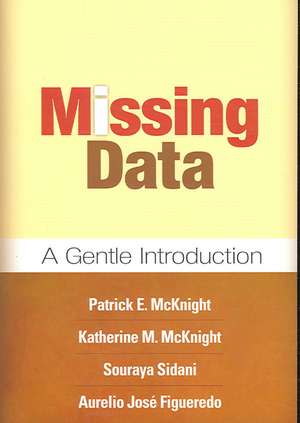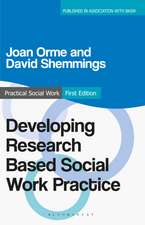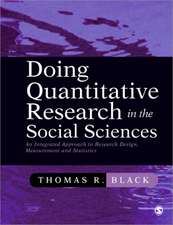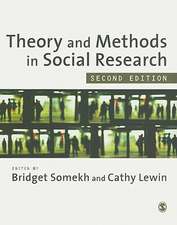Missing Data: A Gentle Introduction: Methodology in the Social Sciences
Autor Patrick E. McKnight, Katherine M. McKnight, Souraya Sidani, Aurelio Jose Figueredoen Limba Engleză Paperback – 24 mai 2007
While most books on missing data focus on applying sophisticated statistical techniques to deal with the problem after it has occurred, this volume provides a methodology for the control and prevention of missing data. In clear, nontechnical language, the authors help the reader understand the different types of missing data and their implications for the reliability, validity, and generalizability of a study’s conclusions. They provide practical recommendations for designing studies that decrease the likelihood of missing data, and for addressing this important issue when reporting study results. When statistical remedies are needed--such as deletion procedures, augmentation methods, and single imputation and multiple imputation procedures--the book also explains how to make sound decisions about their use. Patrick E. McKnight's website offers a periodically updated annotated bibliography on missing data and links to other Web resources that address missing data.
| Toate formatele și edițiile | Preț | Express |
|---|---|---|
| Paperback (1) | 331.50 lei 6-8 săpt. | |
| Guilford Publications – 24 mai 2007 | 331.50 lei 6-8 săpt. | |
| Hardback (1) | 554.34 lei 6-8 săpt. | |
| Guilford Publications – 24 mai 2007 | 554.34 lei 6-8 săpt. |
Din seria Methodology in the Social Sciences
-
 Preț: 371.24 lei
Preț: 371.24 lei - 8%
 Preț: 428.70 lei
Preț: 428.70 lei - 8%
 Preț: 530.61 lei
Preț: 530.61 lei -
 Preț: 374.10 lei
Preț: 374.10 lei - 8%
 Preț: 429.80 lei
Preț: 429.80 lei - 8%
 Preț: 404.82 lei
Preț: 404.82 lei - 8%
 Preț: 462.78 lei
Preț: 462.78 lei - 15%
 Preț: 540.47 lei
Preț: 540.47 lei -
 Preț: 376.10 lei
Preț: 376.10 lei -
 Preț: 500.19 lei
Preț: 500.19 lei -
 Preț: 419.87 lei
Preț: 419.87 lei - 14%
 Preț: 339.29 lei
Preț: 339.29 lei - 23%
 Preț: 486.62 lei
Preț: 486.62 lei - 23%
 Preț: 490.41 lei
Preț: 490.41 lei - 21%
 Preț: 270.85 lei
Preț: 270.85 lei - 25%
 Preț: 329.07 lei
Preț: 329.07 lei - 20%
 Preț: 266.71 lei
Preț: 266.71 lei - 9%
 Preț: 468.18 lei
Preț: 468.18 lei - 14%
 Preț: 339.29 lei
Preț: 339.29 lei
Preț: 331.50 lei
Nou
Puncte Express: 497
Preț estimativ în valută:
63.44€ • 66.15$ • 52.72£
63.44€ • 66.15$ • 52.72£
Carte tipărită la comandă
Livrare economică 21 martie-04 aprilie
Preluare comenzi: 021 569.72.76
Specificații
ISBN-13: 9781593853938
ISBN-10: 1593853939
Pagini: 251
Ilustrații: Illustrations
Dimensiuni: 152 x 229 x 18 mm
Greutate: 0.42 kg
Ediția:1
Editura: Guilford Publications
Colecția Guilford Press
Seria Methodology in the Social Sciences
ISBN-10: 1593853939
Pagini: 251
Ilustrații: Illustrations
Dimensiuni: 152 x 229 x 18 mm
Greutate: 0.42 kg
Ediția:1
Editura: Guilford Publications
Colecția Guilford Press
Seria Methodology in the Social Sciences
Public țintă
Professional Practice & DevelopmentCuprins
1. A Gentle Introduction to Missing Data
1.1. The Concept of Missing Data
1.2. The Prevalence of Missing Data
1.3. Why Data Might Be Missing
1.4. The Impact of Missing Data
1.5. What's Missing in the Missing Data Literature?
1.6. A Cost-Benefit Approach to Missing Data
1.7. Missing Data--Not Just for Statisticians Anymore
2. Consequences of Missing Data
2.1. Three General Consequences of Missing Data
2.2. Consequences of Missing Data on Construct Validity
2.3. Consequences of Missing Data on Internal Validity
2.4. Consequences on Causal Generalization
2.5. Summary
3. Classifying Missing Data
3.1. The Silence That Betokens
3.2. The Current Classification System: Mechanisms of Missing Data
3.3. Expanding the Classification System
3.4. Summary
4. Preventing Missing Data by Design
4.1. Overall Study Design
4.2. Characteristics of the Target Population and the Sample
4.3. Data Collection and Measurement
4.4. Treatment Implementation
4.5. Data Entry Process
4.6. Summary
5. Diagnostic Procedures
5.1. Traditional Diagnostics
5.2. Dummy Coding Missing Data
5.3. Numerical Diagnostic Procedures
5.4. Graphical Diagnostic Procedures
5.5. Summary
6. The Selection of Data Analytic Procedures
6.1. Preliminary Steps
6.2. Decision Making
6.3. Summary
7. Data Deletion Methods for Handling Missing Data
7.1. Data Sets
7.2. Complete Case Method
7.3. Available Case Method
7.4. Available Item Method
7.5. Individual Growth Curve Analysis
7.6. Multisample Analyses
7.7. Summary
8. Data Augmentation Procedures8.1. Model-Based Procedures
8.2. Markov Chain Monte Carlo
8.3. Adjustment Methods
8.4. Summary
9. Single Imputation Procedures
9.1. Constant Replacement Methods
9.2. Random Value Imputation
9.3. Nonrandom Value Imputation: Single Condition
9.4. Nonrandom Value Imputation: Multiple Conditions
9.5. Summary
10. Multiple Imputation
10.1. The MI Process
10.2. Summary
11. Reporting Missing Data and Results
11.1. APA Task Force Recommendations
11.2. Missing Data and Study Stages
11.3. TFSI Recommendations and Missing Data
11.4. Reporting Format
11.5. Summary
12. Epilogue
1.1. The Concept of Missing Data
1.2. The Prevalence of Missing Data
1.3. Why Data Might Be Missing
1.4. The Impact of Missing Data
1.5. What's Missing in the Missing Data Literature?
1.6. A Cost-Benefit Approach to Missing Data
1.7. Missing Data--Not Just for Statisticians Anymore
2. Consequences of Missing Data
2.1. Three General Consequences of Missing Data
2.2. Consequences of Missing Data on Construct Validity
2.3. Consequences of Missing Data on Internal Validity
2.4. Consequences on Causal Generalization
2.5. Summary
3. Classifying Missing Data
3.1. The Silence That Betokens
3.2. The Current Classification System: Mechanisms of Missing Data
3.3. Expanding the Classification System
3.4. Summary
4. Preventing Missing Data by Design
4.1. Overall Study Design
4.2. Characteristics of the Target Population and the Sample
4.3. Data Collection and Measurement
4.4. Treatment Implementation
4.5. Data Entry Process
4.6. Summary
5. Diagnostic Procedures
5.1. Traditional Diagnostics
5.2. Dummy Coding Missing Data
5.3. Numerical Diagnostic Procedures
5.4. Graphical Diagnostic Procedures
5.5. Summary
6. The Selection of Data Analytic Procedures
6.1. Preliminary Steps
6.2. Decision Making
6.3. Summary
7. Data Deletion Methods for Handling Missing Data
7.1. Data Sets
7.2. Complete Case Method
7.3. Available Case Method
7.4. Available Item Method
7.5. Individual Growth Curve Analysis
7.6. Multisample Analyses
7.7. Summary
8. Data Augmentation Procedures8.1. Model-Based Procedures
8.2. Markov Chain Monte Carlo
8.3. Adjustment Methods
8.4. Summary
9. Single Imputation Procedures
9.1. Constant Replacement Methods
9.2. Random Value Imputation
9.3. Nonrandom Value Imputation: Single Condition
9.4. Nonrandom Value Imputation: Multiple Conditions
9.5. Summary
10. Multiple Imputation
10.1. The MI Process
10.2. Summary
11. Reporting Missing Data and Results
11.1. APA Task Force Recommendations
11.2. Missing Data and Study Stages
11.3. TFSI Recommendations and Missing Data
11.4. Reporting Format
11.5. Summary
12. Epilogue
Notă biografică
Patrick E. McKnight, PhD, is Assistant Professor in the Department of Psychology at George Mason University, Fairfax, Virginia. The majority of his work focuses on health services outcomes and, in particular, on measuring those outcomes to make them readily interpretable. He has worked and published in the health-related areas of asthma, arthritis, cancer, speech, pain, low vision, and rehabilitation. Dr. McKnight is an active member of the American Evaluation Association, serving as co-chair of the quantitative methods topical interest group for the past 4 years.
Katherine M. McKnight, PhD, teaches statistics at George Mason University, Fairfax, Virginia, and is Director of Evaluation for LessonLab Research Institute, part of Pearson Achievement Solutions. She has published numerous articles reflecting a wide range of interests, with the common underlying framework of the thoughtful use of research methods, measurement, and data analysis for addressing research and evaluation questions. She is a member of the American Evaluation Association and the Association for Psychological Science.
Souraya Sidani, PhD, RN,is Canada Research Chair, Tier One, in Health Interventions Design and Evaluation at Toronto Metropolitan University.
Aurelio José Figueredo, PhD, is Professor of Psychology at the University of Arizona. He is the director of the graduate program in Ethology and Evolutionary Psychology (EEP), a cross-disciplinary program integrating the studies of comparative psychology, ethology, sociobiology, and behavioral ecology, genetics, and development. His major areas of research interest are the evolutionary psychology and behavioral development of life-history strategy and sex and violence in human and nonhuman animals, and the quantitative ethology and social development of insects, birds, and primates. In the EEP he regularly teaches the graduate year-long course in Statistical Methods in Psychological Research.
Recenzii
"This book is full of useful information about methodological and statistical issues related to missing data. It includes clear definitions of types of missing data, ways to reduce their negative effects, and analytical strategies for maximizing the use of all data--even partial data--collected in a research study. A unique strength of the book is its focus on missing data as a threat to the validity of a study's conclusions. Unlike other sources on missing data analysis, design approaches for preventing missing data are emphasized. More advanced statistical approaches to missing data analysis are also described clearly. This is a valuable, practical resource."--David MacKinnon, PhD, Department of Psychology, Arizona State University
"This very important, interesting, and well-written book addresses a serious problem in contemporary social science research. Statisticians have made considerable progress in developing methodologies for dealing with missing data. However, these methods are not well known to social science researchers or to many graduate students in the behavioral sciences. This book systematically explores methods for classification, diagnosis, and prevention of missing data problems. It provides step-by-step instructions for analyzing data sets with some observations missing; reviews imputation methods; and advises investigators on how to report on analyses when some participants have been lost to follow-up. This is an excellent book that will help behavioral science investigators handle analytical problems for virtually every study they conduct."--Robert M. Kaplan, PhD, Regenstrief Distinguished Fellow, Purdue University; Professor of Medicine and Director of Research, Clinical Excellence Research Center, Stanford University
The authors present a comprehensive discussion of missing data in a nontechnical fashion that will not intimidate those who lack an extensive mathematical background....The book discusses missing data at an introductory level, focusing on how missing data affects scientific research, how it can be prevented or minimized throughout a study, and how it can be appropriately accounted for in the statistical analysis and study conclusions.
--American Statistician, 3/30/2007ƒƒProvides a comprehensive and nuanced discussion of the complexities and variety of solutions. It also offers approaches to reduce the likelihood of obtaining missing data by considering research procedures or design. This book serves as one of the better introductions to this topic for students and will be useful for others seeking a more general overview of approaches for missing data....This book is unique in addressing not only the statistical issues but also in its coverage on preventing the occurrence of missing data as research is planned or conducted, and how missing data should be presented in publications....A very good introduction....Provides some insightful connections between research designs used in psychology or social studies and missing data patterns.
--PsycCRITIQUES, 3/30/2007ƒƒThe information in this book is practical, judicious, and empirically sound. The authors have managed to compile a very useful book on an often repressed topic among researchers. For students, this is a worthwhile introduction that manages to avoid being too technical. Yet, there are very functional suggestions both in terms of study design and the handling of missing data that would be useful for seasoned researchers. Weighted Numerical Score: 97 - 5 Stars!
--Doody's Review Service, 3/30/2007Descriere
While most books on missing data focus on applying sophisticated statistical techniques to deal with the problem after it has occurred, this volume provides a methodology for the control and prevention of missing data. In clear, nontechnical language, the authors help the reader understand the different types of missing data and their implications for the reliability, validity, and generalizability of a study&



















